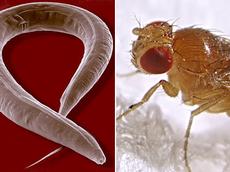What flies and worms have in common
Researchers at ETH Zurich and the University of Zurich have, for the first time, compared the proteomes of two different multi cellular organisms. They found surprising correlations between two animals that, at first sight, couldn’t be more different.

In a new publication in PloS Biology, researchers at the University of Zurich and ETH Zurich have, for the first time, undertaken a comparison of the proteomes of two different multi cellular organisms. The researchers compared the protein catalogue of the tapeworm Caenorhabditis elegans with that of the fruit fly Drosophila melanogaster.
This comparison was possible because, over the past few years, the researchers have been cataloguing the fly’s proteins, with the data being systematically collected in Zurich’s specialist centre for proteome analysis, the “Center for Model Organism Proteomes” (C-MOP) at the University of Zurich.
Investigating the worm
The protein catalogue for the fruit fly was also sourced from a previous study published in 2007. In this study, an international team of researchers, including members of the University of Zurich and ETH Zurich, were able to record and index nearly two thirds of the predicted Drosophila melanogaster proteome – a total of over 9,100 proteins.
The protein makeup of the worm has now been recorded by a team led by Michael Hengartner, Professor of Molecular Biology at the University of Zurich. During the investigation, the university researchers found nearly 11,000 proteins and 10,600 gene loci. Some of the genes have been “rediscovered” as a result of this study. Although they had been predicted by computer calculations, experimental proof has only now been possible with this extended mapping. This allows researchers to refine their genome annotations, i.e. to say more precisely which genes of the genome are active and where within the genome they lie. So far, over 19,000 genes were known for the worm, with 22,000 assigned proteins.
Many proteins overlap
In order to compare the two protein catalogues, the researchers only used a part of the discovered genes with regard to the protein products. They focused on roughly 2,700 orthologous genes. These genes stem from the same ‘parent’ genes and are kept in the newly created organisms. They also keep the same function throughout the process of evolution.
For the majority of such orthologous proteins, the researchers found major parallels between the fly and the tapeworm. “The correlation between the two organisms is surprisingly high”, stresses Michael Hengartner. This despite the fact that the two organisms have developed separately for hundreds of millions of years.
The big differences between the two species, despite their great protein similarity, is due to the many interim steps necessary in the translation of a section of the DNA to the complete protein, with countless possible variations, such as the different regulation of the genes. According to the molecular biologist, “Evolution is able to play with the interim steps”.
As the C. elegans and Drosophila proteins are also similar to human proteins, the researchers suspect that a human/worm proteome comparison would bring similar results.
Unique equipment
Such comparisons require protein databases such as the C-MOP, where data are collected and recorded according to uniform standards by various research groups. This expert centre for proteome data of model organisms is currently deemed to be the world’s only such institution, founded by the predecessor to the current SystemsX.ch, the “old” SystemsX. The ultimate goal is to make the data available, free of charge, to researchers who are also interested in proteomics, thus offering great value for fundamental biological research.
Together with the protein catalogues for Drosophila and C. elegans, the Center for Model Organism Proteomes also has proteome data for Arabidopsis thaliana, the epitome of the model plant. C-MOP has therefore created a unique database on proteins for model organisms.
Simplify the proteome analysis
Proteome research is still very laborious and complex. Whilst genomes can now be completely sequenced relatively quickly and cheaply, it is still difficult to catalogue proteins – the gene products. Ruedi Aebersold would therefore like to further simplify proteome analysis. The idea is to search for proteins that sufficiently characterise the genome, without the proteome having to be fully known.
In order to do this, the ETH professor would, for example, require certain peptide fragments that characterise the proteins. He says, “It’s like a simplified map. You only need a few pointers to find the right way.” He claims that it is important for system biology to be able to gauge proteomes more quickly and cheaply, as biological research also wants to measure changes in an organism. For example, if a gene is blocked, this can create stress at a cellular level. The big question, however, is how the system behaves as a whole, and not just as a faulty signal path.
Difference between humans and chimpanzees
And after all, the researchers want – as in the comparison between worms and flies – to use proteomics to get to the bottom of evolution and the line of descent. For example, chimpanzees and humans have numerous gene sequences in common, yet the two species are still very different, particularly in terms of brain functionality. “The sequence comparison alone does not sufficiently explain this difference”, explains the ETH professor. In order to explain the big differences in development of the phenotype, we would require extensive analysis of the proteins and the networks they form.
References
Schrimpf SP et al.
Comparative Functional Analysis of the Caenorhabditis
elegans and Drosophila melanogaster
Proteomes. PloS Biology 7, Issue 3, published online March 2009. doi: 10.1371/journal.pbio.1000048
Brunner E et al. A high-quality catalog of the Drosophila melanogaster proteome. 2007. Nature Biotechnology 25, 5.
576-583. doi: 10.1038/nbt1300







READER COMMENTS